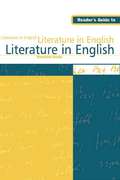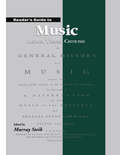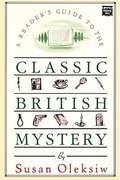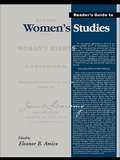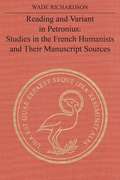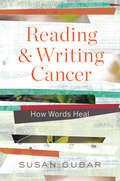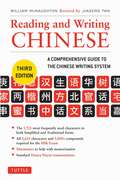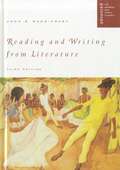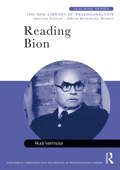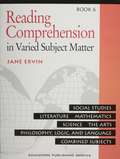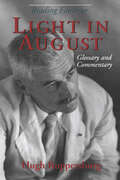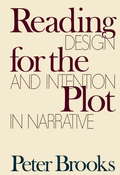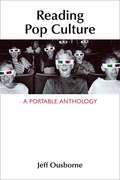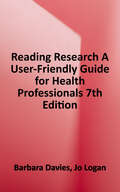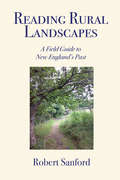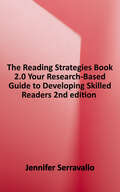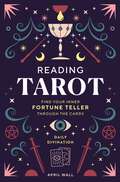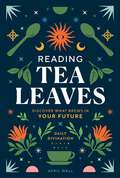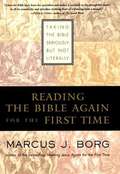- Table View
- List View
Reader's Guide to Literature in English: Null (Reader's Guide Ser.)
by Mark Hawkins-DadyReader's Guide Literature in English provides expert guidance to, and critical analysis of, the vast number of books available within the subject of English literature, from Anglo-Saxon times to the current American, British and Commonwealth scene. It is designed to help students, teachers and librarians choose the most appropriate books for research and study.
Reader's Guide to Music: History, Theory and Criticism
by Murray SteibThe Reader's Guide to Music is designed to provide a useful single-volume guide to the ever-increasing number of English language book-length studies in music. Each entry consists of a bibliography of some 3-20 titles and an essay in which these titles are evaluated, by an expert in the field, in light of the history of writing and scholarship on the given topic. The more than 500 entries include not just writings on major composers in music history but also the genres in which they worked (from early chant to rock and roll) and topics important to the various disciplines of music scholarship (from aesthetics to gay/lesbian musicology).
A Reader's Guide to the Classic British Mystery
by Susan OleksiwLists of characters and their creators; occupations of characters; time periods, locations, and settings of stories; 100 classics; police and local forces; and the British class system
Reader's Guide to Women's Studies
by Eleanor B. AmicoThe Reader's Guide to Women's Studies is a searching and analytical description of the most prominent and influential works written in the now universal field of women's studies. Some 200 scholars have contributed to the project which adopts a multi-layered approach allowing for comprehensive treatment of its subject matter. Entries range from very broad themes such as "Health: General Works" to entries on specific individuals or more focused topics such as "Doctors."
Reading and Variant in Petronius: Studies in the French Humanists and their Manuscript Sources (The Royal Society of Canada Special Publications)
by Wade T. RichardsonCritical editions of most classical authors are based on readings transmitted by medieval scholars that can be examined and collated. Modern editions of Petronius, on the other hand, are principally based on printed editions, most of them published in France during the sixteenth century. In this volume T. Wade Richardson considers the use made of the Petronius manuscripts then extant by seven French humanist editors for their various editions, commentaries, and notes.Some of the manuscripts they used may be equated with extant exemplars, which therefore serve as a good check on the quality of their readings. But as much as half of the text rests on the sixteenth-century witness alone. Through a broad and integrated study of the problems of the Petronius text the author attempts to unravel the tangled skein of humanist work on Petronius, to settle some of the old textual puzzles, and to solidify the text and recast the apparatus.Richardson also provides information on the codicology and palaeography of the texts and on the talents and habits of the scholars who created them.
Reading and Writing
by Ruth Nathan Laura RobbThis is a sourcebook that intends to enhance the readers' reading and writing skills.
Reading and Writing Cancer: How Words Heal
by Susan GubarAn important addition to the literature of cancer by an award-winning scholar and memoirist. Elaborating upon her "Living with Cancer" column in the New York Times, Susan Gubar helps patients, caregivers, and the specialists who seek to serve them. In a book both enlightening and practical, she describes how the activities of reading and writing can right some of cancer's wrongs. To stimulate the writing process, she proposes specific exercises, prompts, and models. In discussions of the diary of Fanny Burney, the stories of Leo Tolstoy and Alice Munro, numerous memoirs, novels, paintings, photographs, and blogs, Gubar shows how readers can learn from art that deepens our comprehension of what it means to live or die with the disease. From a writer whose own memoir, Memoir of a Debulked Woman: Enduring Ovarian Cancer, was described by the New York Times Book Review as "moving and instructive...and incredibly brave," this volume opens a path to healing.
Reading and Writing Chinese
by William Mcnaughton Jiageng FanThis is a compete and easy-to-use guide for reading and writing Chinese characters.Used as a standard by students and teachers in learning Chinese for more than three decades, the bestselling Reading & Writing Chinese has been completely revised and updated. Reading & Writing Chinese places at your fingertips the essential 1,725 Chinese characters' up-to-date definitions, derivations, pronunciations, and examples of correct usage by means of cleverly condensed grids. This guide also focuses on Pinyin, which is the official system to transcribe Hanzi, Chinese characters, into Latin script, now universally used in mainland China and Singapore. Traditional characters (still used in Taiwan and Hong Kong) are also included, making this a complete reference.Newly updated and revised, these characters are the ones officially prescribed by the Chinese government for the internationally recognized test of proficiency in Chinese, the Hanyu Shuiping Kaoshi (HSK). Key features of this newly-expanded edition include:The 1,725 most frequently used characters in both Simplified and Traditional formsAll 2,633 characters and 5,000+ compounds required for the HSK ExamMnemonics to help with memorizationStandard Hanyu Pinyin romanizations More mnemonic phrases and etymologies to help you remember the characters An extensive introduction, alphabetical index, and index according to stroke count and stroke order Completely updated/expanded English definitions Convenient quick-reference tables of radicals Updated and revised compounds, plus 25% more vocabulary now offered Codes to assist those who are preparing for the AP exam or the HSK exam
Reading and Writing Chinese
by William Mcnaughton Jiageng FanThis is a complete and easy-to-use guide for reading and writing Chinese characters.Learning written Chinese is an essential part of mastering the Chinese language. Reading & Writing Chinese places at your fingertips the essential 1,725 Chinese characters' up-to-date definitions, derivations, pronunciations, and examples of correct usage by means of cleverly condensed grids.Newly updated and revised, these characters are the ones officially prescribed by the Chinese government for the internationally recognized test of proficiency in Chinese, the Hanyu Shuiping Kaoshi (HSK). The student's ability to read Chinese and write Chinese are reinforced throughout.Key features of this newly-expanded edition include: The 1,725 most frequently used characters in both Simplified and Traditional forms. All 2,633 characters and 5,000+ compounds required for the HSK Exam. Standard Hanyu Pinyin romanizations. More mnemonic phrases and etymologies to help you remember the characters. An extensive introduction, alphabetical index, and index according to stroke count and stroke order. Completely updated/expanded English definitions. Convenient quick-reference tables of radicals. Updated and revised compounds, plus 25% more vocabulary now offered. Codes to assist those who are preparing for the AP exam or the HSK exam.
Reading and Writing from Literature: AP Version (3rd edition)
by John E. SchwiebertDesigned for use in literature courses that are also writing courses, Reading and Writing from Literature offers a fresh new approach to reading and writing in those classes. The book invokes a "conversation" model of reading and writing that empowers students to interact proactively and constructively with all texts, both literary and their own. Reading and Writing from Literature presents reading as the primary resource for writing. Rather than only writing about literature, student users of this book write from literature; they use texts to produce texts. Being personally and culturally diverse, students are encouraged to identify and use those aspects of a text that interest them most as starting points for composing. Throughout the book, the guiding assumption is that, by creating, students also become stronger readers of the literature of past and present.
Reading and Writing Math Using Windows Based Applications - WBM (World Bank Modules)
by BookshareThis instructional module focuses on enhancing math literacy among teachers and students with visual impairments through Windows-based applications. It begins by addressing the challenges encountered in accessing mathematical content and outlines the learning objectives for the module. Detailed guidance is provided on utilizing Thorium Reader, a versatile reading app supporting various document formats, with screen readers like NVDA, JAWS, and Narrator to access math content. Moreover, the module extensively covers writing math expressions in Microsoft Word, highlighting keyboard shortcuts, the equation editor, and handwriting features while offering tips and links to additional resources. It delves into an overview of assistive technologies like MathType, MathML, EPUB, LaTeX, and Pandoc for reading and writing math, comparing their advantages and suggesting suitable options based on user profiles and needs. Additionally, it explores the feasibility of reading and writing math in Indian languages, acknowledging limitations and challenges. The page concludes by listing the system and software specifications used for testing the solutions elucidated within the module, ensuring comprehensive coverage of accessibility solutions across multiple platforms and applications.
Reading Autobiography: A Guide for Interpreting Life Narratives, Second Edition
by Sidonie Smith Julia WatsonWith the memoir boom, life storytelling has become ubiquitous and emerged as a distinct field of study. Reading Autobiography, originally published in 2001, was the first comprehensive critical introduction to life writing in all its forms. Widely adopted for undergraduate and graduate-level courses, it is an essential guide for students and scholars reading and interpreting autobiographical texts and methods across the humanities, social sciences, and visual and performing arts. Thoroughly updated, the second edition of Reading Autobiography is the most complete assessment of life narrative in its myriad forms. It lays out a sophisticated, theoretical approach to life writing and the components of autobiographical acts, including memory, experience, identity, embodiment, space, and agency. Sidonie Smith and Julia Watson explore these components, review the history of life writing and the foundations of autobiographical subjectivity, and provide a toolkit for working with twenty-three key concepts. Their survey of innovative forms of life writing, such as autographics and installation self-portraiture, charts recent shifts in autobiographical practice. Especially useful for courses are the appendices: a glossary covering dozens of distinct genres of life writing, proposals for group and classroom projects, and an extensive bibliography.
Reading Autobiography Now: An Updated Guide for Interpreting Life Narratives, Third Edition
by Sidonie Smith Julia WatsonA user-friendly guide to reading, writing, and theorizing autobiographical texts and practices for students, scholars, and practitioners of life narrative The boom in autobiographical narratives continues apace. It now encompasses a global spectrum of texts and practices in such media as graphic memoir, auto-photography, performance and plastic arts, film and video, and online platforms. Reading Autobiography Now offers both a critical engagement with life narrative in historical perspective and a theoretical framework for interpreting texts and practices in this wide-ranging field. Hailed upon its initial publication as &“the Whole Earth Catalog of autobiography studies,&” this essential book has been updated, reorganized, and expanded in scope to serve as an accessible and contemporary guide for scholars, students, and practitioners. Sidonie Smith and Julia Watson explore definitions of life narrative, probe issues of subjectivity, and outline salient features of autobiographical acts and practices. In this updated edition, they address emergent topics such as autotheory, autofiction, and autoethnography; expand the discussions of identity, relationality, and agency; and introduce new material on autobiographical archives and the profusion of &“I&”s in contemporary works. Smith and Watson also provide a helpful toolkit of strategies for reading life narrative and an extensive glossary of mini-essays analyzing key theoretical concepts and dozens of autobiographical genres. An indispensable exploration of this expansive, transnational, multimedia field, Reading Autobiography Now meticulously unpacks the heterogeneous modes of life narratives through which people tell their stories, from traditional memoirs and trauma narratives to collaborative life narrative and autobiographical comics.
Reading Bion (New Library of Psychoanalysis Teaching Series)
by Rudi VermoteWilfred R. Bion is considered a ground-breaking psychoanalyst. His thinking is rooted in Freud and Klein from where it takes an original flight. Reading Bion shows the evolution of his seminal insights in psychic functioning and puts them in a wider context. Rudi Vermote integrates a chronological close reading and discussion of Bion’s texts, with a comprehensive approach of his major concepts. The book is divided in two main parts: Transformation in Knowledge: Bion’s odyssey to understand psychic processing or the mind Transformation in O: in which Bion reinterprets his former concepts from the dimension of the unknown and unknowable The running text is put against a background of biographical data and scientific, artistic and philosophical influences on his work, which are highlighted in boxes and separate chapters. Bion’s concepts are important for anyone dealing with the mind. His ideas have an ongoing deep impact on psychoanalysis, psychotherapy and psychopathology. His concepts help to understand psychic change, creativity, individual psychodynamics and small and large-group phenomena. The discovery of their value for studies on art, literature, sociology, religion, economics has just begun. Reading Bion starts from the very beginning so that it is instructive for people who are new to his work, but the close reading and background information make it a meaningful companion for experienced psychoanalysts and psychotherapists studying his work.
Reading Comprehension in Varied Subject Matter, Book 6 (Reading Comprehension, Erc Mrc Ser.)
by Jane ErvinThis popular series offers nonfiction reading passages with comprehension questions on a variety of subjects for students in second grade through junior high school and beyond.
Reading Faulkner: Light in August (Reading Faulkner Series)
by Hugh RuppersburgExplaining the world of William Faulkner's Light in August is the primary goal of this glossary. Like other books in this series, it explains, identifies, and comments on many elements that a reader may find unfamiliar or difficult. These include the basic features of Faulkner's fictional town of Jefferson and Yoknapatawpha County, colloquialisms, dialects, folk customs and sayings, farm implements, biblical verses, and geographic and demographic details. Written especially for puzzled readers, teachers of Faulkner, graduate students, and interpretive scholars, the Reading Faulkner Series books offer terms and explications that reveal the richly cultural world in Faulkner's major works. Page references throughout are keyed to the definitive editions of Faulkner published by Library of America and to the Vintage editions prepared from the Library of America tapes.
Reading for the Plot
by Peter BrooksA book which should appeal to both literary theorists and to readers of the novel, this study invites the reader to consider how the plot reflects the patterns of human destiny and seeks to impose a new meaning on life.
Reading Pop Culture: A Portable Anthology
by Jeffrey OusborneReading Pop Culture: A Portable Anthology is a current, compact, inexpensive collection that taps into students' passionate engagement with popular culture in order to help them to become better writers. Its focus on themes of consumption, advertising, identity, technology, television, movies, and new media prompts composition students to think and write about issues they care about. This volume in the popular Bedford/St. Martin's series of Portable Anthologies and Guides offers a trademark combination of high quality and great value.
Reading, Publishing and the Formation of Literary Taste in England, 1880-1914 (The Nineteenth Century Series)
by Mary HammondBetween 1880 and 1914, England saw the emergence of an unprecedented range of new literary forms from Modernism to the popular thriller. Not coincidentally, this period also marked the first overt references to an art/market divide through which books took on new significance as markers of taste and class. Though this division has received considerable attention relative to the narrative structures of the period's texts, little attention has been paid to the institutions and ideologies that largely determined a text's accessibility and circulated format and thus its mode of address to specific readerships. Hammond addresses this gap in scholarship, asking the following key questions: How did publishing and distribution practices influence reader choice? Who decided whether or not a book was a 'classic'? In a patriarchal, class-bound literary field, how were the symbolic positions of 'author' and 'reader' affected by the increasing numbers of women who not only bought and borrowed, but also wrote novels? Using hitherto unexamined archive material and focussing in detail on the working practices of publishers and distributors such as Oxford University Press and W.H. Smith and Sons, Hammond combines the methodologies of sociology, literary studies and book history to make an original and important contribution to our understanding of the cultural dynamics and rhetorics of the fin-de-siècle literary field in England.
Reading Research: A User-friendly Guide for Health Professionals
by Barbara Davies Jo LoganLearn how to evaluate and apply health sciences research with this beginner's guide! Reading Research: A User-Friendly Guide for Health Professionals, 7th Edition provides a clear introduction to reading and understanding research articles, with practical guidelines for implementing research into clinical practice. It describes how to interpret common research methods including qualitative, quantitative, and mixed-method approaches, and explains how to find relevant, reliable research on the internet. <P><P>Written by Barbara Davies and Jo Logan, both of whom are noted educators and research experts, this easy-to-use pocket guide is ideal for both students and health professionals.
Reading Rural Landscapes: A Field Guide to New England's Past
by Robert SanfordWilliam Faulkner once said, "The past is never dead. It's not even past." Nowhere can you see the truth behind his comment more plainly than in rural New England, especially Maine, New Hampshire, Vermont, and western Massachusetts. Everywhere we go in rural New England, the past surrounds us. In the woods and fields and along country roads, the traces are everywhere if we know what to look for and how to interpret what we see. A patch of neglected daylilies marks a long-abandoned homestead. A grown-over cellar hole with nearby stumps and remnants of stone wall and orchard shows us where a farm has been reclaimed by forest. And a piece of a stone dam and wooden sluice mark the site of a long-gone mill. Although slumping back into the landscape, these features speak to us if we can hear them and they can guide us to ancestral homesteads and famous sites. Notable Features: -Lavishly illustrated with drawings and color photos. -Provides the keys to interpret human artifacts in fields, woods, and roadsides and to reconstruct the past from surviving clues. -Perfect to carry in a backpack or glove box. -A unique and valuable resource for road trips, genealogical research, naturalists, and historians.
The Reading Strategies Book 2. 0: Your Research-Based Guide to Developing Skilled Readers
by Jennifer SerravalloEvidence-based, responsive instruction made easier. - 100 new and 200 heavily revised strategies - 700+ references or links to research studies - Skill progressions for progress monitoring - 200 new student-facing charts - New strategies for advanced middle school readers - Recently published mentor texts used in lesson examples Serravallo brings a practical and proven approach to helping teachers help kids develop as skilled readers. The Reading Strategies Book 2.0 is designed to work in every K-8 classroom, providing strategies and lesson plans for every type of reader. The user-friendly design of The Reading Strategies Book 2.0 makes it easy to find strategies, prompts, and tips that meet every student where they are now. Save prep time and support readers' progress toward skills mastery with classroom-ready features such as revised lesson language with updated mentor texts, teaching tips with advice for differentiation, and mostly new student-facing charts. Whether you are looking for powerful and engaging lessons for whole-class teaching, need to supplement your core curriculum with small-group instruction, want to improve the quality of content-area instruction, or need ideas for intervention, The Reading Strategies Book 2.0 will help you connect research to practice.
Reading Tarot: Find Your Inner Fortune Teller Through the Cards
by April WallReading Tarot not only teaches you how to perform tarot readings but also provides clarity on what matters the most in your life. Whether offering insight into relationships and careers paths or providing a sense of calm and clarity for the day, reading tarot cards is an easy way to practice self-care and self-reflection. Professional tarot card reader April Wall provides guidance throughout all aspects of tarot reading and what you can discover about yourself along the way. For years, April has performed tarot readings for clients in search of answers and teaches how to explore your past, present, and future.This beautifully illustrated guide compiles her years of experience to teach you how to accurately interpret 78 major and minor arcana tarot cards and connect your insights to real-life experiences. Complete with numerous examples, traditional card spread types, and tips to apply what you learn in various love, work, and life scenarios, Reading Tarot gives you all the tools you will need to conduct impactful readings on yourself and others. Take hold of your mystical journey and find the answers in the cards! ALL OF YOUR TAROT QUESTIONS ANSWERED: The only tarot guidebook you will ever need! With thorough explanations, a history of the practice, and application tips, this book is the complete package EXPERT GUIDANCE: Written by an expert in metaphysical practice, this book is an authentic and reliable guide to the practice of tarot EASY TO LEARN: With step-by-step instructions and clear explanations, this guidebook is perfect for any skill level PERFECT GIFT: This book makes the perfect gift for any tarot enthusiast in your life COMPLETE THE SERIES: Collect all of the books in the Daily Divination series with Reading Tarot, Reading Tea Leaves, and more!
Reading Tea Leaves: Discover What Brews in Your Future
by April WallReading Tea Leaves: Discover What Brews in Your Future is the perfect resource to master the ancient practice of tea leaf reading, also known as tasseography, and will teach you everything you need to know to learn and interpret the hidden messages that lie in the shapes of the tea leaves. Author April Wall, a spirit-led psychic intuitive, provides an easy explanation to all aspects of the practice and what you can discover about yourself, the future, and the divination power of reading tea leaves. For years, April has performed tea leaf readings for clients in search of answers. This beautifully illustrated guide compiles her years of knowledge and real-life experience to teach you how to confidently interpret over 100 consistent tea leaf patterns and configurations. Complete with a glossary, step-by-step instructions, and insider tips and tricks, Reading Tea Leaves gives you all the tools you will need to perform your very own tea leaf readings. Take hold of your journey and find the answers you have been looking for! 100+ TEA LEAF SYMBOLS EXPLAINED: With over 100 symbols and configurations explained, you will find success in your tea leaf readings every time EASY TO LEARN: This ancient divination practice is made easy with step-by-step instructions that make learning to read tea leaves simple HELPFUL ILLUSTRATIONS: Each tea leaf symbol will be accompanied by an illustration to help readers accurately interpret the symbols PERFECT GIFT: This guide makes a perfect gift for the aspiring psychic or fan of mysticism in your life COMPLETE THE SERIES: Collect all of the books in the Daily Divination series with Reading Tea Leaves, Reading Tarot, and more!
Reading the Bible Again for the First Time: Taking the Bible Seriously but Not Literally
by Marcus J. BorgOne of the vital challenges facing thoughtful people today is how to read the Bible faithfully without abandoning our sense of truth and history. Reading the Bible Again for the First Time provides a much-needed solution to the problem of how to have a fully authentic yet contemporary understanding of the scriptures. Many mistakenly believe there are no choices other than fundamentalism or simply rejecting the Bible as something that can bring meaning to our lives. Answering this modern dilemma, acclaimed author Marcus Borg reveals how it is possible to reconcile the Bible with both a scientific and critical way of thinking and our deepest spiritual needs, leading to a contemporary yet grounded experience of the sacred texts. This seminal book shows you how to read the Bible as it should be examined -- in an approach the author calls "historical-metaphorical." Borg explores what the Scriptures meant to the ancient communities that produced and lived by them. He then helps us to discover the meaning of these stories, providing the knowledge and perspective to make the wisdom of the Bible an essential part of our modern lives. The author argues that the conventional way of seeing the Bible's origin, authority, and interpretation has become unpersuasive to millions of people in our time, and that we need a fresh way of encountering the Bible that takes the texts seriously but not literally, even as it takes seriously who we have become. Borg traces his personal spiritual journey, describing for readers how he moved from an unquestioning childhood belief in the biblical stories to a more powerful and dynamic relationship with the Bible as a sacred text brimming with meaning and guidance. Using his own experience as an example, he reveals how the modern crisis of faith is itself rooted in the misinterpretation of sacred texts as historical record and divine dictation, and opens readers to a truer, more abundant perspective. This unique book invites everyone -- whatever one's religious background -- to engage the Bible, wrestle with its meaning, explore its mysteries, and understand its relevance. Borg shows us how to encounter the Bible in a fresh way that rejects the limits of simple literalism and opens up rich possibilities for our lives.
